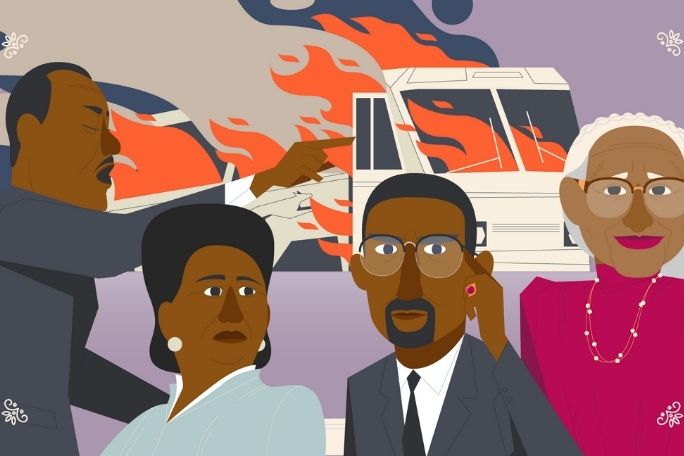Lesson summary
In this Finding Out lesson, students will explore civil rights, with a specific focus on the African American civil rights movement in the United States of America. They will use a ‘Think-Pair- Share’ visible thinking routine to explore their understanding of what civil rights are. The class will discuss a definition of the concept, with a focus on the differences and similarities with human rights. The class will analyse images relating to the reaction to desegregation in the USA, and respond to a set of prompts about them. Students will then research and organise into chronological order a set of key events within the USA civil rights movement. Students will dig deeper into key figures and events in the fight for civil rights, and create a set of exhibits for a class gallery walk. They will then reflect on their new understanding using a ‘Here Now/There Then’ visible thinking routine.
Essential questions:
- How did people campaign for civil rights?
- What is the connection between civil rights and rights and freedoms?
Lesson guides and printables
Lesson details
Curriculum mapping
Australian curriculum content descriptions
Year 10 History:
- The US civil rights movement and its influence on Australia (ACDSEH105)
- Use chronological sequencing to demonstrate the relationship between events and developments in different periods and places (ACHHS182)
- Identify and analyse the perspectives of people from the past (ACHHS190)
Syllabus outcomes: HT5-2, HT5-7.
General capabilities: Literacy.
Relevant parts of year 10 achievement standards: Students refer to key events, the actions of individuals and groups, and beliefs and values to explain patterns of change and continuity over time. They analyse the causes and effects of events and developments and explain their relative importance. They explain the context for people’s actions in the past. Students explain the significance of events and developments from a range of perspectives. Students sequence events and developments within a chronological framework, and identify relationships between events across different places and periods of time. They process, analyse and synthesise information from a range of primary and secondary sources and use it as evidence to answer inquiry questions. Students analyse sources to identify motivations, values and attitudes.
Relevant parts of Year 10 achievement standards:
Unit of work: Story of Our Rights and Freedoms – Year 10.
Time required: 180 mins.
Level of teacher scaffolding: High – support students through interactive activities and facilitate discussions.
Resources required
- Student Worksheet – one copy per student
- Device capable of presenting a video and webpage to the class.
- Student web-enabled devices (enough for one between two)
- Civil Rights Timeline Cards
- USA Civil Rights Gallery Walk Research Guide
- Gallery Walk student notes, printed, one per student
- Poster paper OR devices to create digital presentation (for gallery walk activity)
Skills
This lesson is designed to build students’ competencies in the following skills:
- Collaboration
- Empathy
- Communication
- Cultural understanding
Additional info
Throughout the Story of Our Rights and Freedoms lessons, students will consider Civics and Citizenship concepts through a human rights lens. They will critically assess the Australian system of government and the effect that it has on our rights and freedoms.
There is no universally accepted definition of human rights, and our understanding is continually developing. Some definitions include:
- The recognition and respect of peoples’ dignity
- A set of moral and legal guidelines that promote and protect the recognition of our values, our identity and access to an adequate standard of living
- The basic standards by which we can identify and measure inequality and fairness
- Those rights associated with the Universal Declaration of Human Rights (UDHR)
When we talk about human rights we usually refer to principles that have been agreed upon by countries throughout the world. These rights have been set down in international agreements and form part of international law. They can also be written into the domestic law of individual countries. Human rights cover virtually every area of human life and activity. These include:
- Civil and political rights, such as freedom of speech and freedom from torture
- Economic and social rights, such as the rights to health and education
- Individual rights, including the right to a fair trial
- Collective rights, or those rights that apply to groups of people, such as the right to a healthy environment or to live on one’s ancestral land.
The UDHR is an international document that recognises the basic rights and fundamental freedoms to which all human beings are entitled. It was adopted by the United Nations General Assembly on 10 December 1948 and marks a key milestone in the history of human rights. The Magna Carta, though limited in who it protected, was an important precursor to the UDHR.
Click here to watch a video about the Magna Carta.
You can view the entire text of the Universal Declaration of Human Rights, and the other core international human rights treaties, on the United Nation’s website or by downloading RightsApp (free from the iTunes App store).


Welcome back!
Don't have an account yet?
Log in with:
By signing up to Cool.org you consent and agree to Cool's privacy policy to
store, manage and process your personal information. To read more, please see
our privacy policy here(Opens in new tab).
Create your free Cool.org account.
Many of our resources are free, with an option to upgrade to Cool+ for premium content.
Already have an account?
Sign up with:
By signing up to Cool.org you consent and agree to Cool's privacy policy to
store, manage and process your personal information. To read more, please see
our privacy policy here(Opens in new tab).